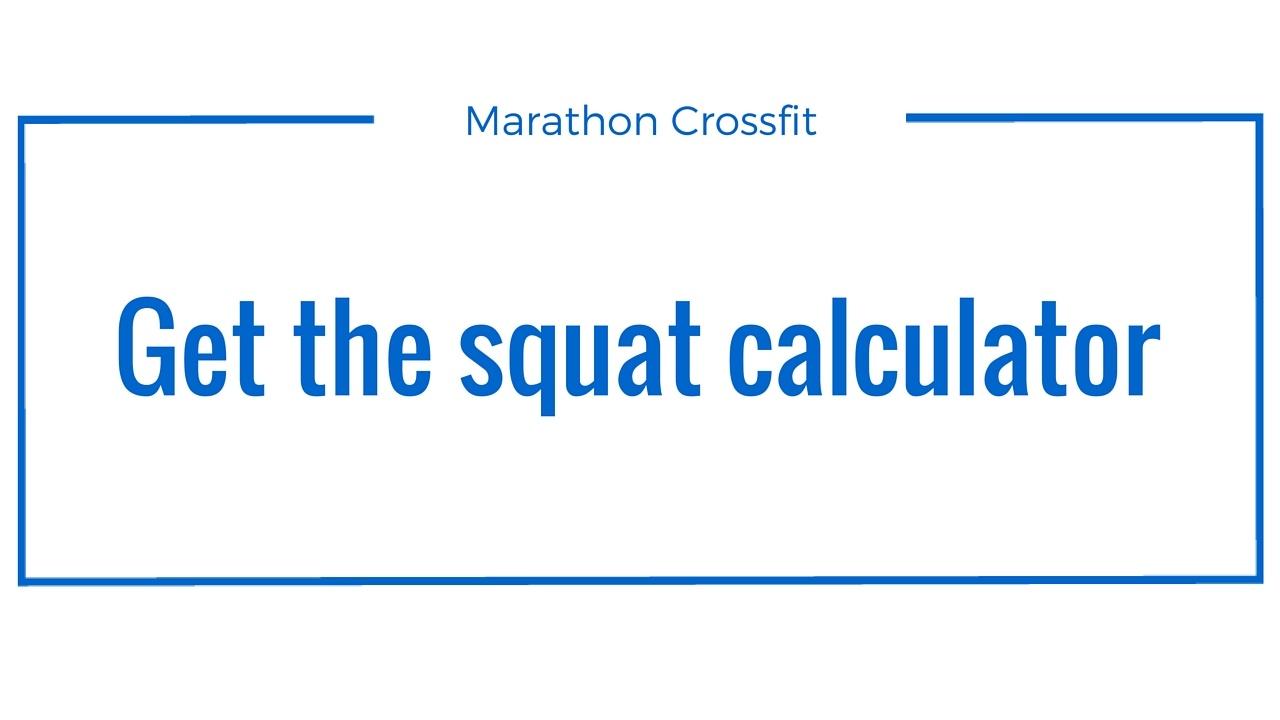Squat Calculator
The free weight squat is one of the most underutilised movements in the gym. For me it expresses real raw power and also flexibility if done correctly. This article will describe different forms of squats, how to pick your weight when you are a beginner and how to keep track of your progression using this calculator.
Intro
This squatting calculator is intended for anyone who is not doing the other two main compund lifts, the deadlift and the bench press calculator. If you wanted to track all three of the lifts maybe have a look at my Jim Wendler Calculator which provides all the informatrion you need for the three lifts.
This calculator will enable you to track your progression on the squat for your one repetition maximum without having to constantly test it. It will also allow you to compare your performance with your peers / training group for motivation or slagging (your pick), and to see whether the program you are running is getting you somewhere or not.
It can be used independently a program that you run, as the rep schemes and sets can be freely choosen by you.
Other calculators
Other calculators on the web are usually either pre baed into some kind of rep scheme for the program that you are running or only available only to evaluate your one repetition maximum once.
Also most ofd them do not provide a track record based on your performance in the past. These two things bugged me and I designed my own Excel spreadsheet for the Jim Wendler program. As I saw that there was quite some interest in the matter I decided to also provide calculators, which can be used free from any rep scheme and for one excercise only like this one. Nothing to contemplated, but if you lack the excel skills to build something like this, I personally think this spreadsheet saves you a week of research and also has 2 years of lifting experience attached to it. This is why I kept it as simple as possible.
Repetitions

In this colums yu will type in the amount of repetitions you did. I would recommend that you only use the last set of your day with the highest amount of weight to keep track of. his is also known as the top set of the day.
So if you are running a 5x5 rep scheme type in your last set with weight. If yyou run a pyramid rep scheme, provide the heaviest set yu did. Basically whatever you have deemed to be the most challenging set of the day is the one you want to track over time for improvement.
There are several variations on the squat which you can do. I would recommend that you open up a tab for each of them, if you were to do several variations, as the variation has usually its own one repetition maximum.

Back Squat
The classic squat with a barbell on your back. Walk out three steps from the rack take a deep breath, brace your abodminal wall and squat as deep as ou can possibly can based on your current mobility. If you can not break below paralell consider to stretch in paralell and to work on your ankle mobility to get the desired depth, as this is usually the limiting factor to the back squat.

Front Squat
Same as the back squat, but with the barbell in front resting on your shoulders. Starting position is the same as you find weightlifters in after they stood up in a clean and jerk. I find this variation of the squat more challenging than the back squat and you usually see that there is less weight being moved in front squats than in back squats.
This is due to the fact that you have not your entire spine to support the weight as in the back squat, you can not pull in the bar into your back like with foremost mentioned variation and that you have to work on wrist mobility besides also working on ankle mobility to perfect the technique for this squat.
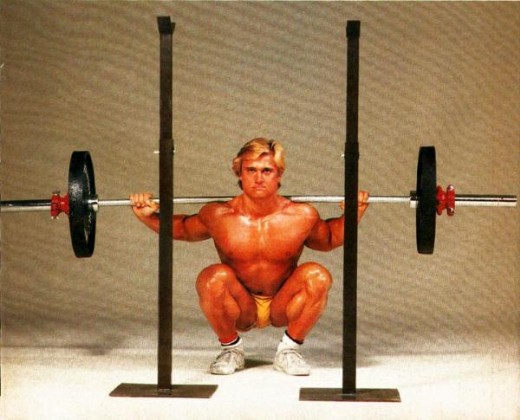
Platz squatz
Tom Platz is a bodybuilder / powerlifter who was famous for his very narrow stance on the backsquat as illustrated in the picture above. Basically this is a fancy word for a clsoe stance squat. If you can perform this I bow my head to you, as it is very challenging to get this deep with such a close stance. The advantage for training is here that you willtr ain more flexibility and that the bar travels further. This means for you, that out of each repetition you will get more muscles trained for longer. The disadvantage is, is that this is not the ideal for establishing a one repetition maximum that is as high in load as possible. Here other varioations of the squat should be preferred.

Powerlifter Squat
A Powerliter squat or wide stance squat is the preferred method if you wanted to move the maximum amount of weight possible. The bar has to travel not as far and your leverages are usually better to finally put more weight on your back for a record. As most powerlifting associations ask you to squat below paralell and any further down, this is sufficient and there the more efficient technique. See how much further away Dan Green, an accomplished powerlifter, is from the ground with his back side, compared to Tom Platz in the other picture. If you do not train for a specific purpose other than bringin up your overall strength, maybe consider incorporating bpoth techniques depending on how flexible you are.
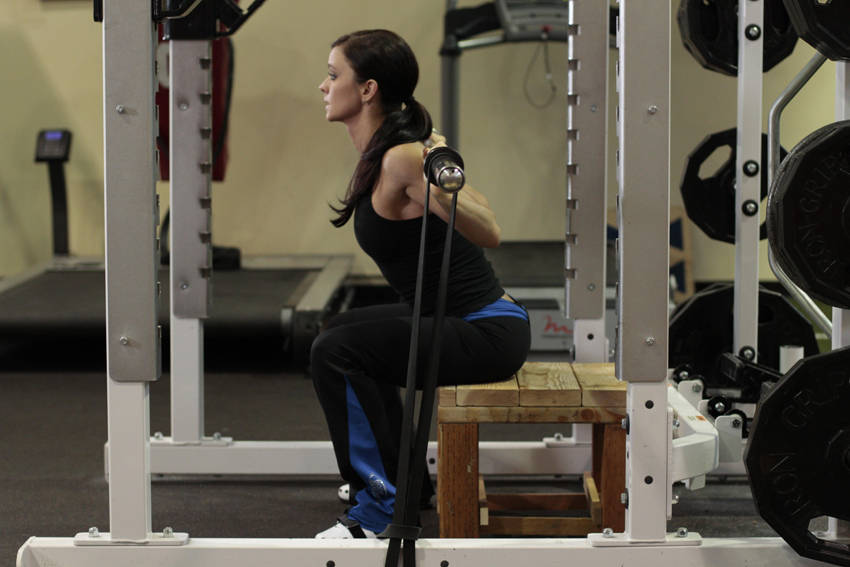
Box Squats
Box Squats are utilised in powerlifting and strength development to lessen the strain on the back when squatting and training for a long time, to develop technique in beginners or to work on explosiveness for experienced lifters. As you are squatting to a box it usual favors a wide stance over a narrow stance and is usually closer related to powerlifting than to bodybuilding.

Squats with chains
You can vary the load of each of these squats by utilising chains. Cains have the benefit that their full load will only by expoerienced at the highest point of the lift as seen in the picture. This will help to develop strength and technique in the lower parts of the lift as you will have less load to move in that range of motion. It will be problematic to work with the calculator for these kind of squats and I would recommend working with the load that you have on the bar + chains for calculations. It really hard to determine which load you are exposed to at which point of the movement with that etchnique.
Squatting with chains is only recommended for advanced lifters who know how to run a program and have proper technique and confidence for the basic movements. Also most commercial gyms either do not allow to squat with chains and also do not provide them, as it is very loud. Chains add unpredictability to the movement which is wanted for experienced lifters, but can lead to a world of pain for strength ethusiasts who have not mastered the basics yet.

Squats with bands
Squats with bands are very similar to squats with chains as they influence the load curve with the highest resistance at the highest point of the lift and less resistance in lower points. This achieves the same results as chains with the only difference that chains provide a deload in jumps when the key chain moves down. Each link of the chain weighs x depending on the overall weight on the chain. When it is lowered to the ground, it is deloaded in the increments represented per link chain weight. For bands this does not apply as their resistancy is based on their elasticity. This means that the load gradually, consistently and evenly increases from the lowest point of the squat to the highest.
Usually squatting with bands is considered more beneficial to deevlopoing explosiveness in lifters compared to chains. However I personally find this variation harder to set up and riskier than chain squats, because of the nature of how the resistance unfolds.

Safety Bar squats
Safety bar squats are very similar to back squats with the only difference that you have a different bar. This bar has handles in the front and also wraps around your neck which makes it easier to control the weight you are moving. It also minimises the amoount of balancing the lifter has to do himself / herself during the lift. These are good variations when experiencing lower back pain for experienced lifters or to build more confidence in the movement for unexperienced lifters.
When you are using the calculator please check with your gym owner how much the provided safety bar weighs, as this can vary considerably, but ois usually more than the standard barbell weight of 20kg.
Conclusion on squat variations
Whichever variation you use be consistent with the worksheet so that results are comparable. As you can see there are many options to choose from. Only compare standard barbell back squats with standard barbell back squats and like with like when progressing in your program. Workyour way from a goblet squat to a barbell squat and then start playing around with different barbells, chains and bands, if needed, based on your goals.
Weight

For this worksheet it does not matter whether you provide the weight lifted in pounds or kilograms. Just choose one from the beginning and stick with it to not confuse yourself. The provided numbers will be crunched automatically and applied to the rest of the worksheet. If you are un experienced and do not know how to pick your weights yet, talk to your gym instructor and research a program which futs your needs. Hereby a bit of input based on what I know.
10 repetitions = Use 40% - 60% of your one repetition maximum
5 repetitions = Use 60% - 85% of 1RM
1 - 3 repetitions = Use 75% to 95%
One repetition maximum

The one repetition maximum is being calculated based on the repetitions and weight your provide. The formula used is provided in the worksheet for number crunchers amongst you who would like to double check. It is taken from Jim Wendler's e book 5/3/1 and I found the results to be accurate for me at 85kg bodyweight and 185cm height. Please keep in mind that these are calculated one repetition maximums. You still have to proof that you can lift the weight in real life, if never lifted before. Therefore I would recommend in a one repetition maximum to go 10% down from what the sheet provides and than get closer to the calculated number with more attempts.
Sinclair Coefficient
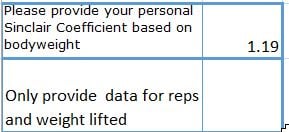
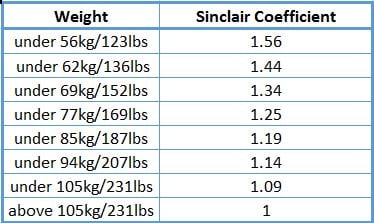
The sinclair coefficient has been established to have a fair way of comparing dsifferent lifters from different weightclasses in terms of strength. Big lifters will usually make a case that the over all weight which has been moved is the ultimate test of strength while lighter lifters will make the case of the ant and sa the ultimate test of strength is how many times over you can lift your bodyweight.
The Sinclaor coefficient attributes a bonus for the lower weight classes which compensates for their lightweight to compare the results in an objective manner. Please pick the coefficient which applies to you for the worksheet and provide it in the column where it is stated for this calculator to fully work for you.
Dynamic

Dynamic work is usually in the 40 - 50% range of your one repetition maximum. This can euther be used for warm up sets or for working on your eplosiveness. This column provides the numbers for you to take out the thinking when looking at your number and know with what load to work.
Advanced Techniques
When you advance as a lifter you might want to try some more advanced techniques this can include:
- Paused squats
Pause in the lowest position for 1 - 3 seconds to than fire up again.
- More repetitions per breath
Rather than doing only one repetition per breath work your way towards 3 or 5 repetitions without having to stop for another breath. Use with caution as this can lead, especially under heavy load, to fainting
- AMRAP sets
AMRAP stands for asmany repetitions as possible. It can be very exciting and challenging to make the last set of the day an all out effort. Only recommended for advanced lifters and heavily utilised in the 531 workout.
Own experience
I started out with back squats and I am now varying with bands and chains. I have not utilised the front squat yet or the safety bar squat as I am happy with my progression. If you take your squatting serious, maybe consider to change from your commercial gym to a "rough and ready" gym as I did. Usually real strength in the free weight section is not that appreaciated as the commercial gyms I have been to were more about bodybuilding.
Conclusion
You can only improve of what you can measure. When I started tracking my progressions for my marathon and lifting it was the frst step to obtain feasible results. I hope with downloading this squat calculator you embark on a similar journey.
Further reading
- Are you sure about wearing the right shoes for squatting
- Bench press or squat first
- Bench press in a squat rack
- Better breathing makes your squat stronger
- Breathing Squat
- Can kettlebells swings replace squats
- Can you squat and deadlift on the same day
- Challenge, Sore
toda , Strong tomorrow - Confidential: Get rid of the machines and hire the squat
- Detailed Smolov squat routine review
- Eager to know about wearing the right suit for squatting
- How to perform a back squat for
crossfit for beginners - How years of quality cossack squats easily help your fitness
- Overcome these sins of the squat
- Squat: How many reps
- Squat: How to improve
- Squat: When to inhale and exhale
- Squat without pads
- The Truth squat or lunges?
- Ultimate 30 day squat challenge that
tighten and tone - What squat is best
- Why are there so many squats in Stronglifts 5x5


